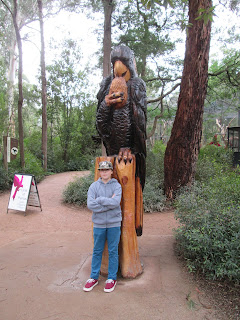Denna helgens utflykt gick alltså till Halesville Sanctuary som är en djurpark lite utanför Melbourne. Denna djurpark har endast djur som finns i Australien så det var lite kul tyckte vi. Speciellt koala och känguru. Vi stannade för en Latte innan vi kom fram :) Melwin åt en munk med sylt i. Här nedan följer en massa bilder, och info, från djurparken. Enjoy!
Väl framme så kom vi ganska snart fram till ett papegojhägn. Och eftersom vi gillar papegojor så var vi snabbt inne hos dem. Här har vi en färgglad liten papegoja som gillade nötter.
The Red-tailed Black Cockatoo is native to Australia.
Male Red-tailed Black Cockatoos are black with red tail bands, while the females are a little smaller and have some yellow patches on their chest, crest, cheeks, wings and tails.
These are large cockatoos, about 60cm in length when adult. They weigh upwards of 600g; some of the males may weigh as much as 900g.
Red-tailed Black Cockatoos eat seeds, mainly Eucalyptus seeds, but also nuts, berries, fruits and some insects.
They are found around most of Australia but more typically in the drier areas of the continent. They prefer Eucalyptus woodlands near water but may also be found in thick eucalyptus forest, rainforest and other areas. They may be seen in large flocks, especially in the north of the country.
Jättefin stor svart Kakadua med toffsen utfälld
Dessa små papegojorna gillade nektar som finns här på fatet. De har små "borst" på tungarn som gör att de kan få upp det lätt.
Detta är den Röda Kängurun, Red Kangaroo. Honorna, som det finns en här på bild, är mer gråfärgade medans hanarna är mer åt det röda hållet.
Kängurur kan röra sig på två olika sätt. När de går långsamt så går de på alla fyra benen. Men när de behöver springa snabbt så använder den bara sina kraftiga bakben att hoppa med och så har de svansen att hålla balansen med. De kan hoppa både långt och högt och springa i 60 km/h
Red Kangaroos breed all year round. Females give birth to a single jelly bean-sized ‘joey’, around 33 days after mating, which will climb up its mother’s belly and into the pouch where it begins to suckle from one of the teats. It remains attached and the milk changes to meet its needs as it grows. At about 6 months old, the joey begins to leave the pouch for short periods, when the mother will usually give birth again. The joeys are permanently out of the pouch at about 8 months of age and normally weaned by around 12 months but can continue to suckle for up to 18 months
Did you know:
Söt Emu
Emus cannot fly. However, they can run, and reach speeds as fast as 40-50km per hour. An adult Emu stands up to 2 metres tall and weighs up to 50kg.
Emus have a broad diet and will eat insects and bugs such as caterpillars. Most of their diet is from vegetation such as fruits, shoots, leaves, seeds and native flowers. Our Emu's at Healesville Sanctuary particularly love endive and apple chips.
In an Emu family, the male builds the nest and incubates the eggs while the female lays 5 to 15 eggs but has no further role in her offsprings’ lives! It is the males who protect the eggs and raise the chicks. Chicks gestate for about two months, and the father protects the eggs for most of this time. After hatching, it is their father who cares for the chicks, for up to 18 months, until they can fend for themselves.
Otroligt söta Koalabjörnarna var en av mina favvisar här!
Did you know:
Det fanns många fina träskulpturer som jag tvingade Melwin att posera bredvid.
Det fanns även väldigt gamla träd, upp mot 250 år. Det satt små skyltar på träden med ålder och vilken typ av träd det var.
Ytterligare en trädskulptur :)
Melwin hittade en rolig lekplats
Sitter och chillar på en dödskalle
Lite gott och blandat! Grön groda, grön orm och en ödla
Små söta Wallabys var vi med och matade med morötter och majs. Det gick även att klappa dem.
Även Rickard vågade ;)
Wallabyn i lilla huset har en unge i pungen så hon ville inte ut därifrån. Men hon fick en morot ändå. Tanten som jobbade där berättade att honorna kan ha upp till 3 bebisar på gång. En lite större som snart ska lämna honan, en typ "nyfödd" som är väldigt liten och bara ligger skyddad där inne och en som bara ligger där i "magen" och väntar på att få utvecklas till en bebis. Den kan ligga där inne och vänta länge på rätt tillfälle att födas. Ungarna lever i pungen ca 1 år.
Det finns flera arter av Wallabys. Detta är en Redneck variant.
Melwin klappade de små liven och ville inte gå därifrån. Men det kom ett flygplan som skrämde bort dem så då passade vi på att lämna.
All fakta text är hämtad från Healesville Sanctuarys hemsida och Wikipedia.




















Inga kommentarer:
Skicka en kommentar